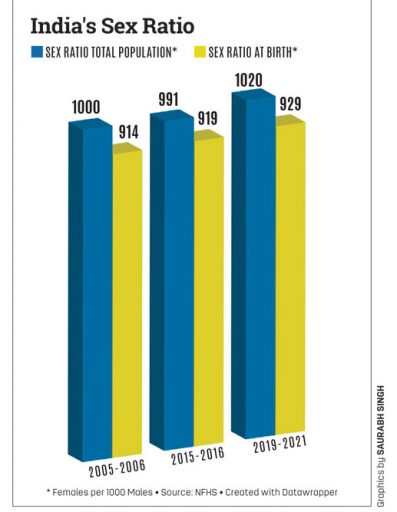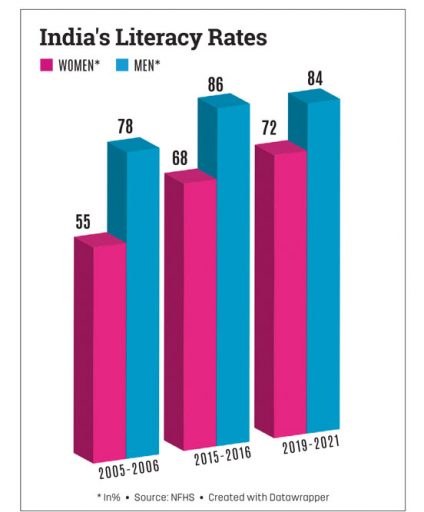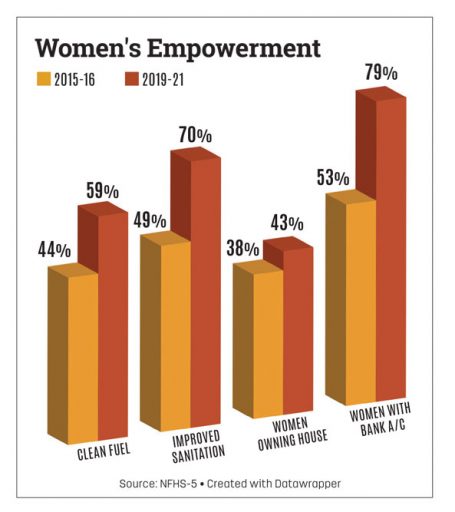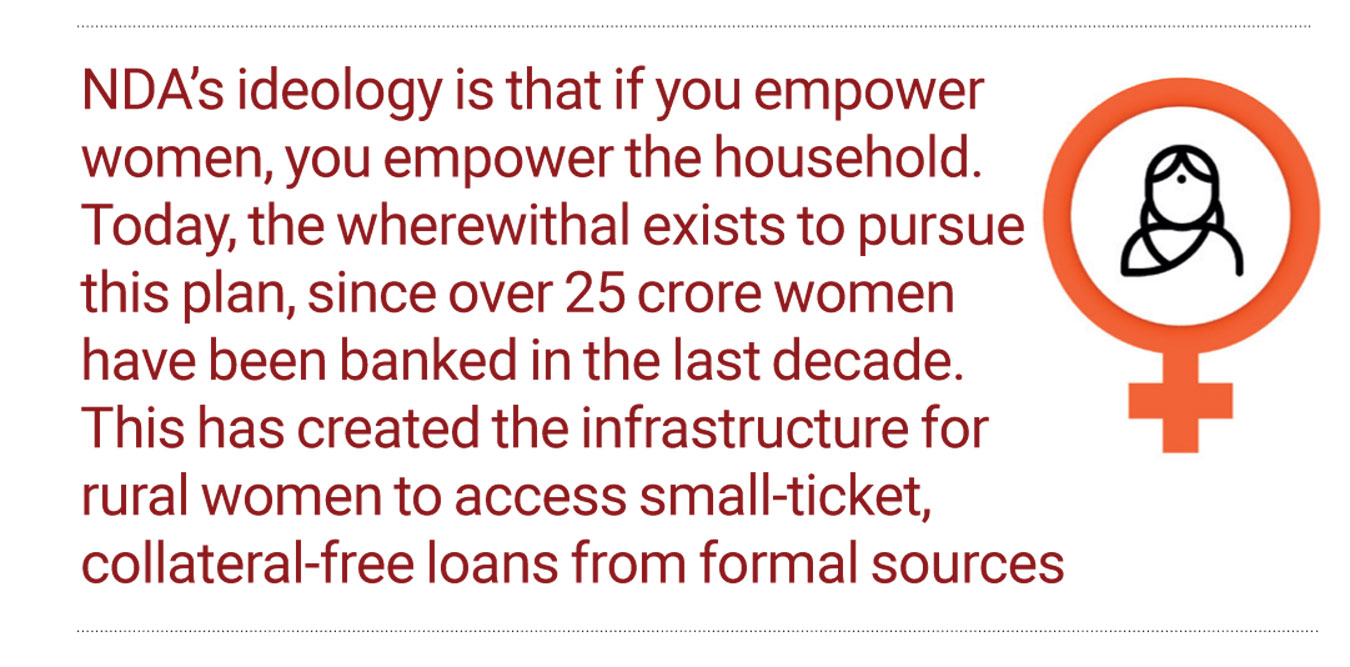The X Factor
A decade of women’s empowerment could be the catalyst for Modi’s victory
 Anil Padmanabhan
Anil Padmanabhan  Anil Padmanabhan
Anil Padmanabhan  | 03 May, 2024
| 03 May, 2024
/wp-content/uploads/2024/05/X-Factor1.jpg)
Prime Minister Narendra Modi with women supporters in Banaskantha, Gujarat, May 1, 2024
Brother and Sisters, we are living in the 21st century. Has it ever pained us that our mothers and sisters have to defecate in the open? Whether the dignity of women is not our collective responsibility? The poor womenfolk in villages wait for night; until darkness descends, they can’t go out to defecate. What bodily torture must they be feeling? How many diseases might this act engender? Can’t we make arrangements for toilets for the dignity of our mothers and sisters?
—Prime Minister Narendra Modi, August 15, 2014
EXHORTING THE NATION for a shameful legacy deficit that had compromised the dignity of women as well as basic hygiene, leaving millions vulnerable to diarrhoeal deaths, Prime Minister Narendra Modi committed his government, barely three months into its first tenure, to providing a toilet in every home and school in the country. At that moment, an estimated 600 million Indians defecated in the open.
Ten years on, India can claim success in having all but ended open defecation. According to the Swachh Bharat Mission dashboard, as of April 30, 2024, 92.2 per cent of the total 5,85,425 villages had been declared open-defecation free.
The prime minister’s debut Independence Day address had included another equally important promise: banking India’s unbanked millions. Little did we know then that this was a very important first step to bring the poor within the purview of the formal economy—enabling access to benefits, hitherto unavailable to them.
“I wish to connect the poorest citizens of the country with the facility of bank accounts through this plan. There are millions of families who have mobile phones but no bank accounts. We have to change this scenario. Economic resources of the country should be utilised for the well-being of the poor,” the prime minister said, and then added, “The change will commence from this point. This yojana will open the window. Therefore, an account holder under Pradhan Mantri Jan-Dhan Yojana (PMJDY) will be given a debit card. An insurance of ₹1 lakh will be guaranteed with that debit card for each poor family, so that such families are covered with the insurance of ₹1 lakh in case of any crisis in their lives.”
Few realised then that a new government was signalling an audacious pivot: from entitlement to empowerment. Effectively, the Bharatiya Janata Party (BJP)-led National Democratic Alliance (NDA) was adopting a new governance maxim: give a person a fish, you feed them for a day. But if you teach them how to fish, you feed them for a lifetime.
This contrasted with the strategy of their predecessor, the Congress-led United Progressive Alliance (UPA), which preferred entitlement—symbolised by the Mahatma Gandhi National Rural Employment Guarantee Scheme (MGNREGS)—which operated as a rural safety net for the poor and has an annual budget that varies between ₹75,000 crore and ₹1 lakh crore.
With the benefit of hindsight, the transformative power of this pivot has been incredible. Efficient execution of social welfare schemes ensured that this impact was amplified. Keep in mind that government schemes—enabling access to basics like banking, electricity, cooking gas, drinking water, housing, and so on—intersect with 60-80 per cent of the lives of an average citizen.
Further, most of these social welfare schemes pursued by NDA on mission mode benefitted women the most. The consequent socio-economic empowerment of women is gradually rewriting their terms of engagement with society in general and politics in particular.

In turn, this new political economy is hitting the reset on India’s polity and has begun to influence electoral choices; in some instances, even outcomes—women voters tilted the balance overwhelmingly in favour of BJP in recently held elections in Madhya Pradesh and for Congress in Karnataka. Nationally though, so far, BJP holds the advantage given that women’s empowerment has been NDA’s pet project. The success is showcased as proof of the ‘Modi ki Guarantee’ election slogan of BJP.
Pradeep Gupta of AxisMyIndia summed it up best in his contribution to the edited volume on Modi@20. “While previous governments promised empowerment of women, Modi made it a reality by opening Jan Dhan accounts that enabled them to receive direct cash transfers. Women could have cash in hand that they could call their own and spend according to their wishes. Women became the proud owners of their homes under the Pradhan Mantri Awas Yojana. They were no longer at the mercy of the men in their house.
Their position was elevated significantly in their homes and, by extension, in society. Everything that was in the files and works, became a reality in the very lifetime of these women.”
HER INDIA
Last September, India celebrated the ninth anniversary of PMJDY. In this period, India managed to bank 50.09 crore people—more than the population of the US. As a result, the proportion of adults holding a bank account rose from 30 per cent in 2014 to 80 per cent at present.
The staggering gains from the rollout of PMJDY can be summed up as follows:
◗ 50.09 crore Jan Dhan accounts opened;
◗ 55.6 per cent (27.82 crore) Jan Dhan account holders are women;
◗ 66.7 per cent (33.45 crore) of Jan Dhan accounts are in rural and semi-urban areas.
According to a research paper published by the Bank for International Settlements (BIS), the bank of central banks headquartered in Basel, Switzerland, this kind of financial inclusion will normally take a country 47 years to achieve. And this in turn would require a country’s per capita income to grow from $5,000 to $20,000.
India did this in nine years, with its growth in per capita income at $2,500, well below the prescribed benchmark. Basically, India, against all odds, shrank the timeline for financial inclusion.
Analysing India’s achievement, the same BIS paper noted, “The increase in financial inclusion was also accompanied by a sharp reduction in the exclusion of marginalised groups (women and poor) more generally. The gender gap—the difference between the shares of men and women with a bank account—diminished from 17% in 2011 to 6% in 2017,” and then added, “The gaps are now all less than world levels.”

On the ground financial inclusion meant much more. By combining an individual’s bank account with their Aadhaar and mobile phone, the government was able to triangulate beneficiaries of social welfare schemes. This trinity, JAM (Jan Dhan, Aadhaar, Mobile), provided a kind of economic GPS whereby the government could undertake Direct Benefit Transfer (DBT).
The power of DBT was most manifest when the Covid-19 pandemic struck India in 2020. Using the DBT mechanism, the Union government was able to transfer much-needed resources to poor households in the country. Even better, with the elimination of ghost accounts and leakages due to corruption, the Union government has cumulatively saved nearly ₹3 lakh crore—as they say, money saved is money earned.
This disintermediation in the payout under social welfare also initiated rewiring of social and political relations at the grassroots level. This is most apparent among the cohort of women.
Especially, if we consider access to cooking gas and drinking water. The former, Pradhan Mantri Ujjwala Yojana (PMUY), was rolled out on May 1, 2016 in Balia, Uttar Pradesh (UP), and each connection was in the name of the woman of the household. Not only did it provide a clean cooking fuel, it also alleviated, in most cases, the drudgery of women trekking distances to collect firewood.
As of March 1, 2024, the women in 10.27 crore households have received a cooking gas connection under PMUY. Assuming four members to a family, this would mean that this welfare programme has impacted 40 crore Indians, especially the homemakers, who are inevitably women.

Not only are they now part of the formal economy, but they have also become key stakeholders in the Indian economy and are experiencing ease of living. The mainstreaming of cooking gas became evident in the elections to the Karnataka Assembly last May. Increase in prices of cooking gas hurt households as the government had capped the subsidy at ₹200.
Karnataka is among the few states that have managed saturation coverage of cooking gas. While the government had solved for availability of cooking gas, it had encountered a new challenge: affordability was denying the aspirational quotient among women. It was a contributory factor in swinging the vote in favour of Congress, which sought to mitigate the load on household budgets through a cash subsidy.
Similar success has accrued in the government’s programme, launched in 2019, to provide access to tap water. This is another legacy deficit that is staggering. For instance, in 2019, 72 years after gaining independence, only 1.94 per cent of rural households in UP, the country’s most populous state, had access to drinking water.
Worse, this negligence is fatal. According to the report released last year by the World Health Organization (WHO), saturation access to drinking water would have prevented up to four lakh diarrhoeal deaths every year.
According to UNICEF (the United Nations Children’s Fund, originally known as the United Nations International Children’s Emergency Fund), the consequences of unsafe Water, Sanitation and Hygiene (WASH) are devastating: “Over 700 children under age five die every day of diarrhoeal diseases due to lack of appropriate WASH services. In areas of conflict, children are nearly 20 times more likely to die from diarrhoeal disease than from the conflict itself.”
It is estimated that every year close to four crore people suffer from water-borne diseases in India. Many, as pointed out earlier, succumb to these ailments.
Sadly, addressing this gap is a business opportunity for water-purifying companies—this market was estimated to have grown to $3 billion in 2022, and is projected to double by 2028. Guess, one man’s loss is another’s gain.

According to WHO, women in India, the primary caregivers of most households, spend roughly an hour each day to collect water for their households. “The majority of this (55.8 million hours) happened in rural areas, and approximately three quarters of this burden (48.7 million hours) was borne by women. Boys and girls spent a total of 3.5 million hours each day collecting water.”
In 2018, all households in India without on-premises water spent 66.6 million hours each day in collecting water, the report added. In short, enabling access to drinking water would make these households time millionaires—imagine the impact on productivity of each household purely because of time saved. Not to speak of avoiding the loss of 14 million DALYs (Disability Adjusted Life Years).
Not surprising then that nationally BJP continues to harvest the social capital associated with scaling access to cooking gas and drinking water. In fact, on New Year’s Eve, Modi turned up at the home of Mera Manjhi, the 10th-crore beneficiary of PMUY. In his conversation with Mera and her family, Modi covered all the touch points of the government’s welfare programmes: access to cooking gas, electricity, housing, banking, and drinking water. Indeed, this was the monetisation of social capital and a masterclass in grassroots politics.
THE ASPIRATIONAL QUOTIENT
A little over a month ago, the Union government released the Monthly Per Capita Expenditure (MPCE) for 2022-23. The latest data comes after a gap of a decade—normally, it is supposed to be released every five years—and provides a very revealing snapshot of India’s rapidly transforming consumption behaviour: mirroring the surging aspirational quotient among its citizens.
Broadly, the MPCE survey tells us:
◗ Materially, India traded up;
◗ Disposable incomes have grown across all income classes. Some more than others;
◗ Consumption expenditure has nearly trebled in absolute terms;
◗ Signalling an increase in disposable incomes, people are spending less on food and more on non-food items like durables;
◗ Convergence in rural and urban spending habits is growing.
Pull all these trends together and it is clear that aspirational consumers are finally finding their feet, growing the nation’s consumer economy. It is not that they discovered their aspirations. They have always had them. Instead, it is just that they now have the means—disposable income—to fulfil their aspirations.
We saw the first signs of India materially trading up in the Census 2011 numbers. The latest MPCE data signals an acceleration in this makeover. Information gleaned from other data sets—including the lifting of 415 million out of poverty—reinforces this larger narrative. In a relative sense, the lot of Indians, including women, has improved in general.

This trend is amplified by a happy convergence of two developments. The rapid rollout of infrastructure, particularly rural roads—in the last 10 years, NDA completed 7.23 lakh kilometres of roads, which is twice the road length created between 2000 and 2014—and the rise of FinTech. The latter is making it possible for startups and legacy financial institutions, like the State Bank of India, to create customised products to cater to growing entrepreneurial desires.
What this has done is transform the material basis for most of India, providing a foundation for self-help groups (SHGs) organised around women to stoke aspirations collectively.
LAKHPATI DIDIS
Sensing the opportunity to scale women’s empowerment, the Union government announced its aspirational Lakhpati (millionaire) Didi programme based on SHGs to enable financial independence among women in rural areas by monetising diverse income generating opportunities—such as tailoring, dairy farming, plumbing, repairing drones, and so on.
Addressing the nation on Independence Day last year, Modi argued the importance of centring development round women. As part of this strategy, he reiterated the government’s audacious commitment to create two crore Lakhpati Didis in villages by empowering SHGs.
“Today 10 crore women are involved in women self-help groups and if you go to a village with women self-help groups, you will find bank didis, Anganwadi didis and didis who distribute medicines. And now my dream is to create a base of two crore lakhpati didis in the villages,” he had said.

Clearly, the guiding ideology of NDA is that if you empower women, then you empower the household. This is because the priorities of women are improving the collective good of the household. Today, the wherewithal exists to pursue this plan, since over 25 crore women have been banked in the last decade. In turn, this has created the infrastructure for this cohort to access and service small-ticket collateral-free loans from formal sources, especially in rural India.
SHGs formed by members of low-income households collectively ring-fence the lending risks. As a result, members of an SHG are guaranteed by their peers to avoid default. The additional advantage is that access to formal loans entails a substantially lower interest cost compared to the usurious rates offered by money lenders. According to data shared by industry insiders, delinquencies are less than 3 per cent of the outstanding loans.
Significantly, the private sector, especially microfinance institutions, too, has sensed a business opportunity in the changed circumstances to extend livelihood-related consumer loans. The commercial logic is understandable.
For instance, a two-wheeler ownership will dramatically improve the productivity of a plumber, carpenter, or electrician. Simply because mobility makes it possible for them to take on more jobs in a wider geographical area. Further, extra income to any household reduces its risk of default, as much as it expands a family’s net worth.
According to the microfinance industry, the average ticket size of these livelihood-related loans is around ₹50,000. They have so far extended such loans to eight crore individuals—effectively empowering a third of the total households in India. As these livelihood impacts stack up, the consequent socio-economic transformation is likely to be very profound, rewriting the rules of engagement as it were.
The arc of Prime Minister Modi’s two Independence Day speeches—the first in 2014 and the one last year—captures the Union government’s ambitions of achieving this kind of socio-economic makeover. It provides ballast to BJP’s campaign and wind to its poll pitch: Modi ki Guarantee.

/wp-content/uploads/2024/11/Cover-ModiFaith.jpg)






/wp-content/uploads/2024/11/Defender1.jpg)
/wp-content/uploads/2024/11/ALoser.jpg)
/wp-content/uploads/2024/11/APassagefromIndia1.jpg)

More Columns
Madan Mohan’s Legacy Kaveree Bamzai
Cult Movies Meet Cool Tech Kaveree Bamzai
Memories of a Fall Nandini Nair